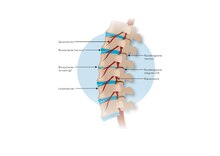Facet syndrome
| Classification according to ICD-10 | |
|---|---|
| M47.2 | other spondylosis with radiculopathy |
| ICD-10 online (WHO version 2019) | |
As facet syndrome or facet joint syndrome refers to a ( pseudoradicular ) pain symptoms, the (usually chronic) by irritation of the so-called facet joints ( facet joints ) is limited. Facet syndrome is a common cause of back pain , which in turn is one of the most common reasons for a doctor's visit. The cause of the facet syndrome is usually the wear and tear of this joint ( spondylarthrosis ) or these joints.
Symptoms
The clinical picture occurs most frequently in the lumbar spine , as this is where the load caused by the weight of the body lying on it and the high degree of mobility is highest and therefore wear and tear starts the earliest. Typical here are pain at the level of the pathologically changed joints or just below it, often radiating towards the legs. Since the facet joint nerves are side branches of the immediately adjacent nerve root , the radiation of pain of a facet syndrome is similar to the irritation of a nerve root ( root irritation syndrome, radiculopathy), but without the sensory disorders characteristic of root irritation syndrome such as numbness, tingling or a furry feeling. As a rule, the pain does not radiate down that far and does not follow the typical skin area supplied by a nerve root ( dermatome ). Typically, the pain is exacerbated by stress on the facet joints, e.g. B. by bending into the hollow back (retroflexion) or side bending, but also by standing or walking for a long time. Patients with facet syndrome often report starting pain in the morning. Even turning around in bed at night causes discomfort for some of them (pain in repositioning).
A facet syndrome can also develop in the area of the cervical spine , especially after a whiplash .
diagnosis
The diagnosis is mainly based on the medical history ( anamnesis ) and the physical examination. Since facet syndrome is difficult to distinguish from non-specific back pain in the early stages and non-specific back pain often improves (spontaneously) without further measures, diagnostic imaging such as x-rays , computed tomography (CT) or magnetic resonance imaging ( magnetic resonance imaging , MRI) is only required if there are no indications of a dangerous course recommended in the case of long-term symptoms (> 6–12 weeks) with no improvement tendency under conservative therapy. While the X-ray of the corresponding spinal column section gives a rough overview of the shape and arrangement of the vertebral joints and vertebral bodies, CT and MRI can prove the wear of the vertebral joints without superimposing, if necessary provide direct indications of an acute irritation of a certain vertebral joint as well as other possible diseases, such as z. B. exclude a herniated disc (see differential diagnosis).
Indications of a potentially dangerous course (so-called “red flags”) would be pain as a result of a fall, new paralysis, a known or suspected tumor disease, indications of an infection of the spine or an age under 30 years.
Differential diagnosis
Alternative diagnoses (differential diagnosis) are disc herniation , spinal canal stenosis , vertebral slipping , fracture (break) of a vertebral body or the sacrum , hip arthrosis , irritation of the sacrum and iliac joint , more rarely tumors or metastases of the spine, even more rarely femoral head necrosis , very rarely irritation of the lumbar acrosis due to retroperitoneal tumors and piriformis syndrome to be considered.
therapy
As a rule, anti-inflammatory drugs are initially used unspecifically . If there is no improvement, a facet infiltration can bring relief, in which a local anesthetic, usually in combination with a cortisone preparation ( corticoid ), is injected into the affected joint. This is usually done under imaging control in the CT or image converter, since a blind injection misses the vertebral joint and especially the joint space. With at least short-term improvement, cryotherapy and facet denervation are used as longer-lasting measures in selected cases.
literature
- Karl Joachim Munzenberg: Orthopedics in Practice. 2nd, completely revised edition. Edition Medicine - VCH Verlagsgesellschaft, Weinheim 1988, ISBN 3-527-15320-9 , pp. 297-299.
- National Care Guideline for Low Back Pain 2010
Individual evidence
- ↑ Alphabetical directory for the ICD-10-WHO version 2019, volume 3. German Institute for Medical Documentation and Information (DIMDI), Cologne, 2019, p. 259.
- ↑ Dr. Dorothea Ranft: pain when turning over in bed? Look for facet syndrome! In: Medical Tribune. April 23, 2018, accessed July 10, 2019 .
- ↑ a b National Health Care Guideline (NVL) low back pain.
